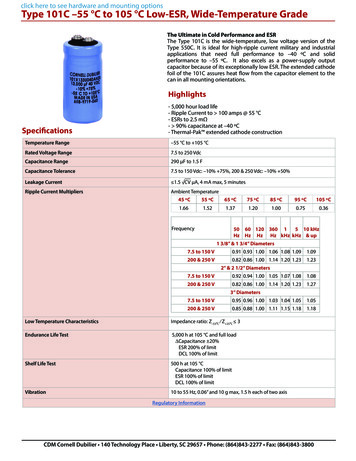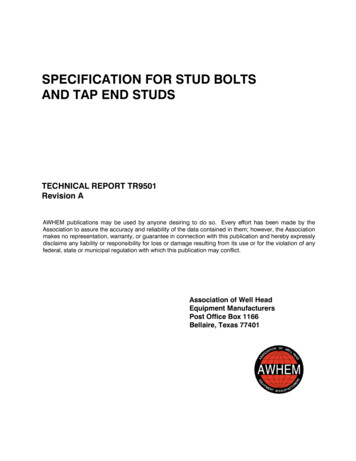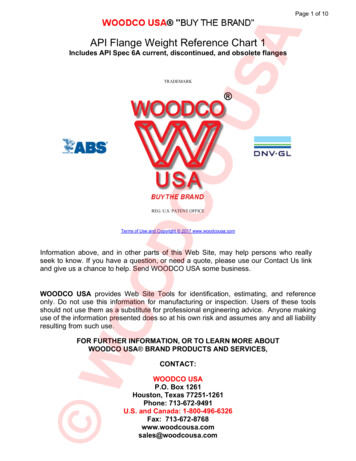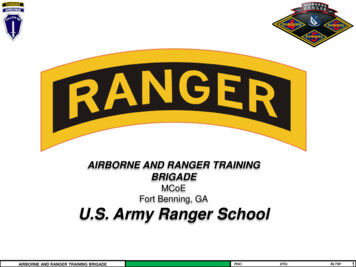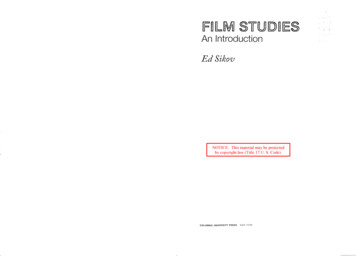
Transcription
F lM STUD ESAn IntroductionEd SikovNOTICE: This material may be protectedby copyright law (Title 17 U. S. Code).COLUMBIA UNIVERSITY PRESSNEW YOflK,J')
COLUMBIA UNIVERSITY PRESSPublishers Since I893NEW YORKCHICHESTER, WEST SUSSEXCopyright 2010 Ed SikovALL F11GH rs RESEFlVEDLibrary of Congress Cataloging-in-Publication DataSikov, Ed.Film studies : an introduction I Ed Sikov.p. cm. -(Film and culture)Includes index.ISBN 978-0-231-14292-2 (cloth : alk. paper) paper) 1.ISBN 978-o-231-q293-9 (pbk.: alk.ISBN 978-0-231-51989-2 (ebook)l'vlotion pictures.PN199,p535 20!0I. Title.II. Series.2009033082Columbia University Press books arc printed on permanent and durable acid-free paper.'Tiiis book is printed on paper with recycled content.Printed in the United States of Americac10 9 8P10ue6 5 4 3 2csReferences to Internet Web sites (URLs) were accurate at the time of writing. Neither theauthor nor Columbia University Press is responsible for URLs that may have expired orchanged since the manuscript was prepared.'!he author and Columbia University Press gratefully acknowledge permission to quote material from John ilclton, Amaicm1 Ci11011a/.1l111.:rica11 Culture, 3d c l. (New York: McGraw-I-I ill,20 08);copyright 2008 'Ihc McGraw-Hill Comp rnics, Inc.
CHAPTER 1MISE-EN-SCENE: WITHIN THE IMAGEWHAT IS MISE-EN-SCENE?Film studies deals with the problems of reality and representation bymaking an initial assumption and proceeding logically from it. Thisassumption is that all representations have meaning. 1he term MISEEN-SCENE (also mise-en-scene) describes the primary feature of cinematic representation. Mise-en-scene is the first step in understanding how films produce and reflect meaning. It's a term taken from theFrench, and it means that which has been put into the scene or put onstage.Everything-literally everything-in the filmed image is described bythe term mise-en-scene: it's the expressive totality of what you see in asingle film image. Mise-en-scene consists of all of the eleinents placed infront of the camera to be photographed: settings, props, lighting, costumes,makeup, and figure behavior (1neaning actors, their gestures, and their facial expressions). In addition, mise-en-scene includes the camera's actions
and angles and the cinematography, which simply means photographyfor motion pictures. Since everything in the filmed image comes underthe heading of mise-en-scene, the term's definition is a mouthful, so ashorter definition is this: lvlise-en-scene is the totality of expressive contentwithin the image. Film studies assumes that everything within the imagehas expressive meanings. By analyzing mise-en-scene, we begin to seewhat those meanings might be.The term mise-en-scene was first used in the theater to describe thestaging of an action. A theater director takes a script, written and printedon the page, and makes each scene come alive on a stage with a particular set of actors, a unique set design, a certain style of lighting, andso on. The script says that a scene is set in, say, a suburban living room.Okay, you're the director, and your task is to create a suburban livingroom scene on stage and make it work not as an interchangeable, indistinguishable suburban living room, but as the specific living room ofthe particular suburban characters the playwright has described on thepage-characters you are trying to bring to life onstage. The same holdstrue in the cinema: the director starts from scratch and stages the scenefor the camera, and every element of the resulting image has expressivemeaning. Even when a film is shot on LOCATION-at a preexisting, realplace-the director has chosen that location for its expressive value.It's important to note that mise-en-scene does not have anything todo with whether a given scene is "realistic" or not. As in the theater, filmstudies doesn't judge mise-en-scene by how closely it mimics the worldwe live in. Just as a theater director might want to create a thoroughlywarped suburban living room set with oversized furniture and distortedwalls and bizarrely shaped doors in order to express her feeling thatthe characters who live in this house are crazy, so a film director createsmisc-en-scene according to the impression he or she wishes to create.Sometimes misc-en-scene is relatively realistic looking, and sometimesit isn't.Herc's the first shot of a hypothetical film we're making: we see aman standing up against a wall. The wall is made of . what? Wood?Concrete? Bricks? Let's say bricks. Some of the bricks are chipped. Thewall is . what color? White? No, let's say it's red. It's a new wall. No, it'san old wall, and some graffiti has been painted on it, but even the graffitiis old and faded. Is it indoors or outdoors? Day or night? We'll go withoutdoors in the afternoon. The man is . what? Short? No, he's tall. Andhe's wearing . what? A uniform-a blue uniform. With a badge.Bear in mind, nothing has happened yet in our film-we just have apoliceman standing against a wall. But the more misc-en-scene detailswe add, the more visual information we give to our audience, and theMISE-EN-SCENE: WITHIN THE IMAGE 6more precise our audience's emotional response will be to the image weare showing them. But also bear in mind the difference between writtenprose and filmed image. As readers, you have just been presented with allof these details in verbal form, so necessarily you've gotten the information sequentially. With a film image, we seem to sec it all at once. Nothing is isolated the way things are in this written description. With film,we take in all the visual information quickly, and we do so without beingaware that we're taking it in. As it happens, studies of human perceptionhave proven that we actually take in visual information sequentially aswell, though a great deal more speedily than we do written information.Moreover, filmmakers find ways of directing our gaze to specific areas inthe image by manipulating compositions, colors, areas of focus, and soon. By examining each of these aspects of cinema, film studies attemptsto wake us up to what's in front of us onscrccn-to make us all moreconscious of what we're seeing and why.To continue with our example of mise-en-sccne: the man is handsome in a Brad Pitt sort of way. He's a white guy. In his late thirties. Buthe's got a black eye. And there's a trace of blood on his lower lip.So we've got a cop and a wall and some stage blood, and we film himwith a motion picture or video camera. Nothing has happened by chancehere; we, the filmmakers, have made a series of artistic decisions evenbefore we have turned on the camera. Even if we happen to have juststumbled upon this good-looking cop with a black eye standing againsta brick wall and bleeding from the mouth, it's our decision not only tofilm him but to use that footage in our film. If we decide to use the footage, we have made an expressive statement with it. And we have cloneso with only one shot that's maybe six seconds long. This is the power ofmisc-en-scene.What's our next shot? A body lying nearby? An empty street? Another cop? A giant slimy alien? All of these things arc possible, and allof them arc going to give our audience even more information aboutthe first shot. Subsequent shots stand in relation to the first shot, and bythe time you get to the tenth or twentieth or hundredth shot, the sheeramount of expressive information-the content of individual shots, andthe relationships from shot to shot-is staggering. But we're gettingahead of ourselves; this is the subject of chapter 4.THE SHOTBy the way: what is a s 1-1 OT? /1 shot is the basic element ofjilmmaking-apiece offilm run through the camera, exposed, and developed; an uninter-7 MISE-EN-SCENE: WITHIN THE IMAGE
Irupted run cf the camera; or an uninterrupted image on film. That's it: youturn the camera on, you let it run, you turn it off, and the result-provided that you have remembered to put film in the camera-is a shot.It's an unedited shot, but it's a shot nonetheless. It's the basic buildingblock of the movies.Despite the use of the word scene in the term mise-en-scene, miseen-scene describes the content not only of a sequence of shots but of anindividual shot. A shot is a unit of length or duration-a minimal unitof dramatic material; a scene is a longer unit usually consisting of severalshots or more.Even at the basic level of a single shot, mise-en-scene yields meaning.The first shot of an important character is itself important in this regard.Here's an example: Imagine that you are going to film a murder movie,and you need to introduce your audience to a woman who is going to bekilled later on in the film. What does the first shot of this woman looklike? What does she look like? Because of the expressive importance ofmise-en-scene, every detail matters. Every detail is a statement of meaning, whether you want it to be or not. ('These are precisely the questionsAlfred Hitchcock faced when he made his groundbreaking 1960 film,Psycho.) Is she pretty? What does that mean? What is she wearing? Whatdoes that mean? If she's really attractive and wearing something skimpywell, are you saying she deserves to be killed? What if she's actually quiteugly-what are you saying there? Do you want your audience to like heror dislike her? It's your choice-you're the director. So what signals areyou going to send to your audience to get that emotion across? Let's sayyou're going to put something on the wall behind her. And it's . a bigstuffed bird. No, it's . a pair of Texas longhorns. No, it's . a brokenmirror. No, it's a crucifix. Or maybe it's just a big empty wall. Each ofthese props adds meaning to the shot, as docs the absence of props anddecorative elements.This is why mise-en-scene is important: it tells us something aboveand beyond the event itself. Again: mise-en-scene is the totality of expressive content within the image. And every detail has a meaningfulconsequence.Let's say you're filming a shot outdoors and a bird flies into thecamera's field of vision and out the other side. Suddenly, a completelyaccidental event is in your movie. Do you keep it? Do you use that shot,or do you film another one? Your film is going to be slightly differentwhichever TAKE you choose. (A take is a single recording of a shot. If thedirector doesn't like something that occurs in Take l, she may run theshot again by calling out "Take 2"-and again and again-"Take 22""Take 35"-"Take 59"-until she is ready to call "print!") If you're mak-MISE-EN-SCENE: WITHIN THE IMAGE 8ing the kind of film in which everything is formally strict and controlled,then you probably don't want the bird. If however you're trying to capturea kind of random and unpredictable quality, then your little bird accidentis perfect. When film students discuss your work, they'll be talking aboutthe bird-the significance of random events of nature, perhaps even thesymbolism of flight. 'That bird is now part of your film's mise-en-scene,and it's expressing something-whether you want it to or not. Whethercritics or audiences at the multiplex specifically notice it or not, ii s there.It's a part of the art work. It's in the film, and therefore it has expressivemeaning.Here's an example from a real film called Gentlemen Prefer Blondes, a1953 musical comedy starring Marilyn Monroe and Jane Russell. There'sa scene in which Jane Russell performs a musical number with a crew ofathletes on the American Olympic team. The number was supposed toend with a couple of the muscle boys diving over Jane Russell's shouldersas she sits by the side of a swimming pool. As it turned out, however,one of the actors accidentally kicked her in the head as he attemptedto dive over her into the pool. With the camera still running, the film'sglamorous star got. knocked violently into the water and came up looking like the proverbial drowned rat. It was obviously an accident. Butthe director, Howard Hawks, decided to use that take instead of any ofthe accident-free retakes he and his choreographer subsequently filmed.Something about the accident appealed to Hawks's sensibility: it expressed something visually about sex and sex roles and gender and animosity and the failure of romance. There's a sudden and shocking shift inmise-en-scene, as Jane Russell goes from being the classically made-upHollywood movie star in a carefully composed shot to being dunked ina pool and coming up sputtering for air, her hair all matted down, andimprovising the end of the song. Hawks liked that version better; it saidwhat he wanted to say, even though it happened entirely by chance. 'Iheshot, initially a mistake, took on expressive meaning through its inclusion in the film.SUBJECT-CAMERA DISTANCE-WHY IT MATTERSAt the end of Billy Wilder's Sunset Boulevard (1950), an aging star turnsto her director and utters the famous line, "I'm ready for my close-up."But what exactly is a close-up? Or a long shot? And why do these termsmatter?One way directors have of providing expressive shading to each shotthey film is to vary the distance between the camera and the subject9 MISE-EN-SCENE: WITHIN THE IMAGE
being filmed. Every rule has its exceptions, of course, but in general,the closer the camera is to the subject, the more emotional weight thesubject gains. (To be more precise, it's really a matter of how close thecamera's lens makes the subject seem to be; this is because a camera's lensmay bring the subject closer optically even when the camera is physicallyfar away from the subject. See the glossary's definition of TELEPHOTOLENS for clarification.) If we sec an empty living room and hear thesound of a telephone ringing on the soundtrack but we can't immediately find the telephone onscreen, the call may seem relatively unimportant. But if the director quickly cuts to a CLOSE-UP of the telephone,suddenly the phone call assumes great significance. Because the directorhas moved the camera close to it, the phone-once lost in the livingroom set-becomes not only isolated within the room but enormous onthe screen.A close-up is a shot that isolates an object in the image, making it appearrelatively large. A close-up of a human being is generally of that person'sface. An extreme close-up might be of the person's eyes-or mouth-ornose-or any element isolated at very close range in the image.Other subject-camera-distance terms are also simple and selfexplanatory. A MEDIUM SHOT appears to be taken from a medium distance; in terms of the human body, it's from the waist up. A THREEQUARTER SHOT takes in the human body from just below the knees; aFULL SHOT is of the entire human body. A LONG SHOT appears to betaken from a long distance. Remember: lenses arc able to create the illusion of distance or closeness. A director could conceivably usea telephotolens on a camera that is rather distant from the subject and still create aclose-up. The actual physical position of the camera at the time of thefilming isn't the issue-it's what the image looks like onscreen that matters. The critical task is not to try to determine where the camera wasactually placed during filming, or whether a telephoto lens was usedto create the shot, but rather to begin to notice the expressive results ofsubject-camera distance onscreen.There are gradations. You can have medium close-ups, taken fromthe chest up; extreme long shots, which show the object or person at avast distance surrounded by a great amount of the surrounding space.at the end of a western, the final shot of the film is an extreme longshot of an outlaw riding off alone into the desert, the director may beusing the shot to convey the character's isolation from civilization, hissolitude; we would see him in the far distance surrounded by miles ofempty desert. Imagine how different we would feel about this characterif, instead of seeing him in extreme long shot, we saw his weather-beatenface in close-up as the final image of the film. We would be emotionallyH:MISE-EN-SCENE: WITHIN THE IMAGEI0"/[EJQ[].\FIGURE 1.1Extreme close-up: a single eyedominates the inw.ge.FIGURE 1.2\Close-up: the character's face fillsmost of the screen.L.JL.JFIGURE 1.3Medium shot: the c!wracter appearsfrom tho waist up.FIGURE 1.4Long shot: because the camera !1asmoved back even further, the character nowupponrs in a complete spatial context.FIGURE 1.5Extrorne long shot: the carnern 1snow very far CJ.way from the clrnracter, t!1erebydwarfing him onscroon. Wh3t are the ernotion .:1llyexpressive qu Jlities of ench of these illustratirn1s(figs. 1 .1 through 1.5)?
as well as physically closer to him at that moment because we wouldbe able to read into his face the emotions he was feeling. His subtlestexpressions-a slightly raised eyebrow, a tensing of the mouth-wouldfill the screen.Here's a final observation on subject-camera distance: Each film establishes its own shot scale, just as each filmmaker establishes his or herown style. Whereas Orson Welles in Citizen Kane (1941) employs an extreme close-up of Kane's lips as he says the key word, "Rosebud," Howard Hawks would never push his camera so close to a character's mouthand isolate it in that way. The Danish director Carl Theodor Dreyer shothis masterpiece The Passion ojJoan of/lrc (1928) almost entirely in closeups; as a result, what would be a long shot for Dreyer might be a mediumshot for John Ford or Billy Wilder. If we begin with the idea that thehuman body is generally the measure for subject-camera distance, thenthe concept's relativity becomes clear: a close-up is only a close-up inrelation to something else--the whole body, for example. The same holdstrue for objects and landscape elements. In short, we must appreciatethe fact that subject-camera distances are relative both within individualfilms-the sequence in Citizen Kane that includes the extreme close-upof Kane uttering "Rosebud" begins with an equally extreme long shot ofhis mansion-and from film to film: Dreyer's close-ups differ in scalefrom those used by Ford or Wilder.IIIFIGURE 1.0FIGUREEye-level shot: the camera places us at the character's i·1eight-w0're equals.1.7 Low-angle shot: we're looking up at her; low-angle sho'.s sornetirnes aggrnndile the shot'ssubject.FIGURE LBHigh-angle shot: we're looking down Jt her now; this type of shot may suggestClcertainsuperiority over a clwracter.FIGURE1.9 Bird's-eye shot: this stiot is taken from the highest possible angle. What might be theexpressive consequences of this shot?FIGURE 1.10Dutch tilt (or canted angle) shot: the camem ls not on its normal horizontal or vertical axes,and the resulting image is off-kilter; Dutch tilts are sornetimes used to sugg 3st a character's unbalanced mental state.CAMERA ANGLEIn addition to subject-camera distance, directors employ different camera angles to provide expressive content to the subjects they film. Whendirectors simply want to film a person or room or landscape from anangle that seems unobtrusive and normal (whatever the word normalactually means), they place the camera at the level of an adult's eyes,which is to say five or six feet off the ground when the characters arestanding, lower when they are seated. 'Il1is, not surprisingly, is called anEYE-LEVEL SHOT.When the director shoots his or her subjects from below, the resultis a LOW-ANGLE SHOT; with a low-angle shot, the camera is in effectlooking up at the subject. And when he or she shoots the subject fromabove, the result is a HIGH-ANGLE SHOT; the camera is looking down.An extreme overhead shot, taken seemingly from the sky or ceiling andlooking straight down on the subject, is known as a BIRD'S-EYE VIEW.'Il1e terms close-up, low-angle shot, extreme long shot, and others assume that the camera is facing the subject squarely, and for the most partMISE·EN-SCENE: WITHIN THE IMAGE12shots in feature films are indeed taken straight-on. But a camera can tiltlaterally on its axis, too. When the camera tilts horizontally and/or vertically it's called a DUTCH TILT or a canted angle.Of everything you read in this book, the opposite also may be true attimes, since every attempt to define a phenomenon necessarily reduces itby ignoring some of the quirks that make films continually interesting.1here's a fine line to tread between providing a useful basic definition thatyou want and need and alerting you to complications or outright contradictions that qualify the definition. This is certainly true with any discussion of the expressive tendencies of low-angle and high-angle shots.Typically, directors use low-angle shots to aggrandize their subjects. After all, "to look up to someone" means that you admire that person. Andhigh-angle shots, because they look down on the subject, are often used13 MISE·EN·SCENE: WITHIN THE IMAGE
to subtly criticize the subject by making him or her seem slightly diminished, or to distance an audience emotionally from the character. At times,a camera angle can in fact distort the object onscreen. By foreshorteningan object, for example, a very high angle shot does make an object or person appear smaller, while a very low angle can do the opposite.But these are just broad tendencies, and as always, the effect of aparticular camera angle depends on the context in which it appears.Film scholars can point to hundreds of examples in classical cinema inwhich a high- or low-angle shot produces an unexpected effect. In Citizen Kane, for instance, Welles chooses to film his central character in alow-angle shot at precisely the moment of his greatest humiliation, anda technical device that is often employed to signal admiration achievesexactly the opposite effect by making Kane look clumsy and too big forhis surroundings, and therefore more pitiable and pathetic.FIGURE 1.11Two-shot: the definition is self-explanatory, but note the equalizing q1Jality of thi.3 type of shot; these twocharacters have the sarne visual weight in a single shot.FIGURE 1.12Three-shot: the two-shot's socially b81anced quality expand3 to include a third person, but note thegreater subject-camera distance that g0es along with 1t in this exmnple.FIGURE 1.13Master shot th l whol0 set-in thi3 case, a dining room-and all the charE.lctors ciro taken in by this typeof shot.r--------------·/MISE·EN·SCENE: WITHIN THE IMAGEl1-1\IL\1
-- -Shots can also be defined by the number of people in the image.Were a director to call for a close-up of his protagonist, the assumptionwould be that a single face would dominate the screen. When a directorsets up a TWO-SHOT, he or she creates a shot in which two people appear, generally in medium distance or closer, though of course there canbe two-shots of a couple or other type of pair walking that would revealmore of their lower bodies. The point is that two-shots are dominatedspatially by two people, making them ideal for conversations.A THREE-SHOT, of course, contains three people-not three peoplesurrounded by a crowd, but three people who are framed in such a wayas to constitute a distinct group.Finally, a MASTER SHOT is a shot taken from a long distance that includes as much of the set or location as possible as well all the charactersin the scene. For example, a scene set in a dining room could be filmed inmaster shot if the camera was placed so that it captured the whole dining table, at least two of the four walls, all of the people sitting aroundthe table, and maybe the bottom of a chandelier hanging over the table.1he director could run the entire scene from beginning to end and, later,intercut close-ups, two-shots, and three-shots for visual variation anddramatic emphasis.SPACE AND TIME ON FILMLike dance and theater, film is an art of both space and time. Choreographers move their dancers around a stage for a given amount of time,and so do theater directors with their actors. But a dance can run sloweror faster some nights, especially if it isn't connected to a piece of music.And if the actors in a play skip some of their lines or even talk fasterthan usual in a given performance, the play can run shorter some nightsthan others.But a no-minute film will be a no-minute film every time it isscreened, whether on the silver screen at a multiplex or on a standardspeed DVD player in your living room. 'Il1is is because sound film runsat a standard 24 frames per second, and it does so not only through thecamera when each shot is individually fi'l1ned but also through the projectorwhen it is played in a theater. In the early days of cinema, camera operators cranked the film through their cameras by hand at a speed hoveringas close as possible between 16 and 18 frames per second. If camera operators wanted to speed actions up onscreen, they would UNDERCRANK,or crank slower: fewer frames would be filmed per second, so when thatfootage was run through a standard projector at a standard speed, theMISE-EN-SCENE: WITHIN THE IMAGE16-.---- - action would appear to speed up. If they wanted to create a slow-motioneffect, they would do the opposite: they would OVERCRANK, or crankfaster, causing the projector to slow the movement down when the shotwas projected. In short, undercranking produces fast motion, while overcranking produces slow motion.'Ilic introduction of SYNCHRONIZED SOUND FILM-characters being seen and heard speaking at the same time onscreen-in the later92os meant that the IMAGE TRACKS and the SOUNDTRACKS had to beboth recorded and projected at the same speed so as to avoid distortion.24 frames per second was the standard speed that the industry chose.You'll learn more about sound technology in chapter 5. And althoughvideotape-unlike film's celluloid-is not divided into individual frames,the same principle applies: video's electromagnetic tape is recorded atthe same speed at which it is transmitted and screened. A 60-minutevideo will always run 60 minutes-no more, no less.'Il1ere is a philosophical point to film's technical apprehension oftime. Unlike any other art form, motion pictures capture a seeminglyexact sense of real time passing. As the great Hollywood actor JamesStewart once described it, motion pictures are like "pieces of time." Thenagain, a distinction must be made between real time, the kind measuredby clocks, and reel time-the pieces of time that, for example, SpikeLee manipulated by editing to create Malcolm X, a film that covers thecentral events of a 39-year-old man's life in 202 minutes.One familiar complication, of course, is that when films are shownon television they are often LEXICONNED to fit them into a time slotand squeeze in more commercials. Lexiconning involves speeding up theoilo))o!'00Dl I00/0J11 1dioljl ii11!10010000FIGURE 1.1400A strip of celluloid, divided by frames, with thesoundtrar::k running vertically down the left alongside the irnagefram0s.17 MISE-EN-SCENE: WITHIN THE IMAGE
standard 24 frames per second by a matter of hundredths of a frameper second, which may shorten the film as much by as 6 or 7 percentof its total running time. Also note the familiar warning that accompanies movies on TV: "Viewer discretion is advised. The following filmhas been modified from its original version. It has been formatted to fitthis screen and edited to run in the time slot allotted and for content."People who love films hate this Procrustean process. (Procrustes wasa mythical king who had a bed to which he strapped and tortured hisvictims. 'Those who were too short for the bed were stretched to fit it,and those too tall had their heads and legs chopped off.) Would an artgallery trim the top, bottom, and sides of a painting just so it would fitinto a preexisting frame?COMPOSITIONOne confusing aspect of film studies terminology is that the word FRAMEhas two distinct meanings. '!he first, described above, refers to each individual rectangle on which a single image is photographed as the strip ofcelluloid runs through a projector. 'That's what we're talking about whenwe say that film is recorded and projected at 24 frames per second: 24 ofthose little rectangles are first filled with photographic images when theyare exposed to light through a lens, and then these frames are projectedat the same speed onto a screen.But the word frame also describes the borders of the image onscreenthe rectangular frame of darlmess on the screen that defines the edge ofthe image the way a picture frame defines a framed painting or photograph. Sometimes, in theaters, the screen's frame will be further definedby curtains or other masking. Your television set's frame is the metal orplastic edge that surrounds the glass screen. In fact, you can make thrcequarters of a frame as you sit reading this book simply by holding yourhands in front of you, palms out, and bringing your thumbs together.'Ihe top of this handmade frame is open, but you can get a good senseof why the frame is an important artistic concept in the cinema just bylooking around your room and framing various objects or even yourselfin a mirror.Note that your literally handmade frame is more or less a square ifyou keep your thumbs together. Now create a wider rectangle by touching your right forefinger to your left thumb and vice versa. See how thisframing changes the way the room looks. And be aware of the subjcctcamera distance and camera angle of the imaginary shots you create. Askyourself why certain "shots" look better than others. Do you find that youMISE·EN·SCENE: WITHIN THE IMAGE18have a taste for oblique angle close-ups, for example, or do you see theworld more at eye level?'Il1e precise arrangements of objects and characters within theframe-the picture-frame kind of frame-is called co MP o s I TI o N. Eachtime you moved your handmade frame, you created a new composition,even if you didn't move any objects around on your desk or ask yourroommate to move further away.As in painting, composition is a crucial element of filmmaking. Infact, composition is a painterly term. (Few if any art critics ever refer tothe mise-en-scene of a painting.) Composition mea
single film image. Mise-en-scene consists of all of the eleinents placed in front of the camera to be photographed: settings, props, lighting, costumes, makeup, and figure behavior (1neaning actors, their gestures, and their fa cial expressions).

